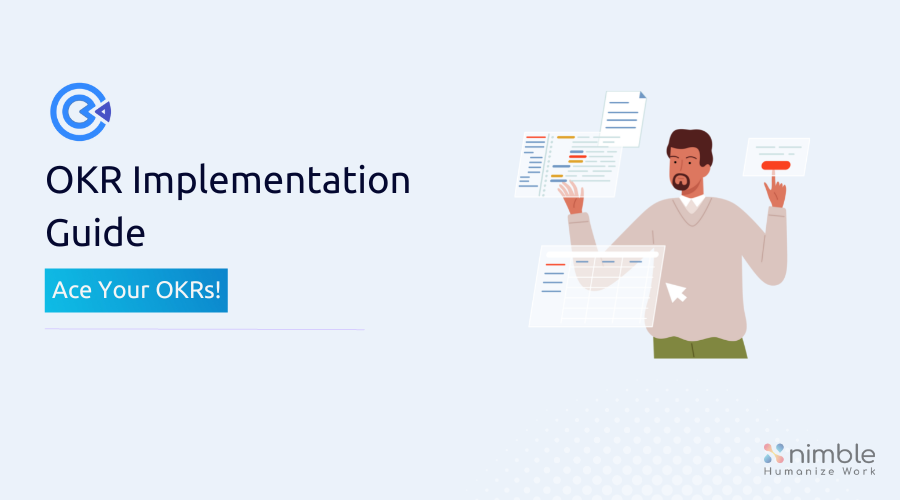OKRs vs. KPIs: Navigating the Metrics Maze – Differences, Examples, and Real-World Applications
Explore OKRs vs. KPIs: Uncover differences, examples, and real-world insights. Elevate your goal-setting and performance measurement strategies.
_____________________
_____________________

Industry leaders such as Google, Adobe, and Microsoft are using OKRs to great success.
You want yourself some of that.
But adopting OKRs within your own company doesn’t sound that easy. You know it involves far more than “just” setting goals.
So how do you set yourself up for success with them?
How do you get the benefits and avoid the obvious pitfalls?
You realize that if you set the stage for OKRs properly, you’ll be far more likely to succeed with them and able to join the likes of the aforementioned giants in telling your success stories.
What you need is someone to talk you through the important preparation steps, to give you an OKR implementation guide.
Well, say no more. Read on to find just that.
But let’s start with a short refresher. Just in case.
OKRs, short for Objective and Key Results, is a framework to align everyone with your organization’s objectives and have them working towards key results directly tied to those objectives.

You start with the objectives.
OKR objectives are the ambitious goals your organization envisions to achieve its mission.
They are usually vague and maybe even a bit abstract.
That’s by design. They’re not meant to be measurable goals. They’re meant to inspire and give direction, to provide focus and guide effort.
For example: Increase brand awareness.
That’s hardly SMART, is it? So, how would you measure your progress towards that?
That’s where key results come in.
OKR key results are the specific, measurable, indicators to tell you how you’re doing in your journey towards your objective.
Obviously, you want key results that are tightly linked to your objective.
And you’ll want more than one key result for each objective. After all, pursuing any valuable business objective involves many tactics, each with their own indicators.
For our “Increase brand awareness” objective, the key results could be:
1. the number of thought leadership articles you publish.
2. the number of social media messages you post on various social media to promote those articles.
3. the number of social media messages you post on other topics related to your brand.
4. the trend in the number of newsletter signups.
5. the trend in the number of active newsletter subscribers.
And finally, you set targets for each key result.

OKR targets are the specific values you want to achieve for each key result. They are the OKR goals.
For example, for the key result “number of thought leadership articles you publish” the target could be 4 per month.
And now, here’s the OKR implementation guide I promised with the essential tips to get the most out of adopting (implementing) OKRs in your organization.
Before making any change to your organization, you have to get buy-in from the top-level and make it trickle down to everyone in the organization.
OKRs are no different.
According to John Doerr, the man who introduced OKRs to Google, buy-in is the first and most important part to adopting OKRs.
Teams need to be committed to the change and see its value for it to happen.
Without buy-in, you’re likely to experience push back and go much slower.
When it comes to acing your OKRs, psychological safety is another essential ingredient.
The creativity, innovation, and capacity for change in your organization depends on your people’s willingness to take risks, ask questions, make suggestions, and generally speak up.
To do so, people need to feel safe.
So, it’s paramount for your organizational success and OKR adoption to create an environment where your people can thrive.
Quite often goals get set and then forgotten until a formal evaluation.
Just think about the goals set during annual appraisals. After a few weeks, sometimes days, they’re out of mind until next year’s appraisal.
OKR key results and OKR targets can suffer the same fate.
You want to keep your OKRs front and center at every level throughout your organization.
Tracking and prominently displaying current values and trends of OKR key results and the progress towards their targets, is a good way to sustain that attention.
Adopting OKRs is no different from any major organizational change and is likely to run into challenges such as lowered productivity, pushback, and a general lack of understanding why this change is needed.
Enlisting the help of someone who knows how to adopt OKRs effectively and coach your team to success — an OKR leader — can make an enormous difference.
An OKR leader helps everyone adopt and apply OKRs more readily and easily, by answering questions, smoothing out bumps, and pointing out where teams may be veering off track.
Before an OKR leader can make a difference, your teams need to learn about the mechanics of OKRs.
They need to understand how to define and prioritize objectives at their level, as well as how to identify the key results instrumental in achieving them.
It’s important that any training you offer also includes OKR frameworks, like templates and goal voting systems, and how to use them.
OKRs have relatively short timeframes to be achieved, usually a quarter.
Even so, it’s important to meet far more often and at a regular cadence to evaluate progress and adjust or redirect activities to improve results.
Frequent and regular evaluations also help keep everyone focused on their OKRs.
If you’re already working in regular intervals — for example, Scrum Sprints or Kanban Cadences — you can simply leverage those for evaluating OKR progress as well.
When making a change as large as implementing OKRs into your organization, there will undoubtedly be a few bumps in the road.
The way to smooth them out is open, two-way communication.
So, don’t just spread the word but listen too — feel the pulse.
And, don’t wait for questions and concerns to come to you, go look for them by making yourself available and being curious.
It’ll help your people to voice their concerns and go a long way to fostering trust in you and in the OKR adoption process.
Nowadays many teams are hybrid with some in the same office and others elsewhere.
It means you‘ll need great tools for communication and collaboration across locations, on day-to-day activities and, of course, on setting and tracking OKRs.
With that in mind, it’s good to know that Nimble OKR is designed adopt the OKR philosophy and help everyone to set align their goals and create measurable outcomes. Its integration with Nimble — our adaptive work/project management solution, closes the loop on them with easy, automatic tracking of your progress.
And if you’re using Slack for communication, you may want to check out Slack OKRs.
You now know all you need to know to set yourself up for success and enjoy the benefits of OKRs, just like the big guns do.
So go ace your OKRs.
And remember to tell us about your success.
OKRs 101
OKRs vs. KPIs: Navigating the Metrics Maze – Differences, Examples, and Real-World Applications
Explore OKRs vs. KPIs: Uncover differences, examples, and real-world insights. Elevate your goal-setting and performance measurement strategies.
What is an OKR goal? What is an OKR objective?
Implementing OKRs can be a great way for organizations to create organization-wide goals that keep motivation and alignment high, and in this post, you’ll learn more about this framework.
Tracking OKRs: Where the Real OKR Magic Happens
Implementing OKRs: 11 Do’s and 8 Don’ts for OKR Success
OKR Implementation Guide: 8 Tips to Ace Your OKRs
OKR Targets and Psychological Safety: At Odds or a Match Made in Heaven
SMART Goals or OKRs Targets for Motivational Power?
Join 150,000+ Pioneers, Leaders & Mavericks receiving our updates!

